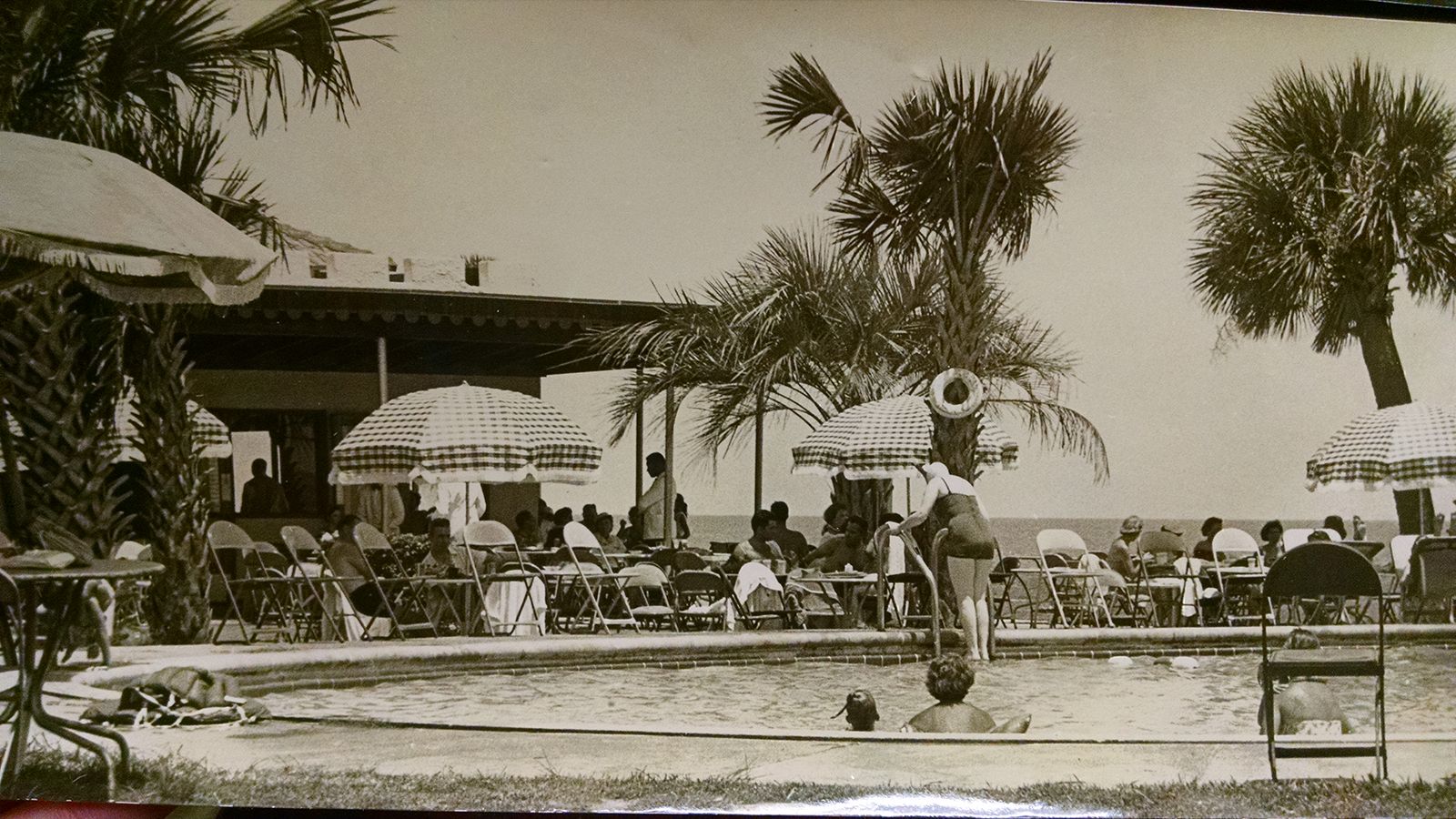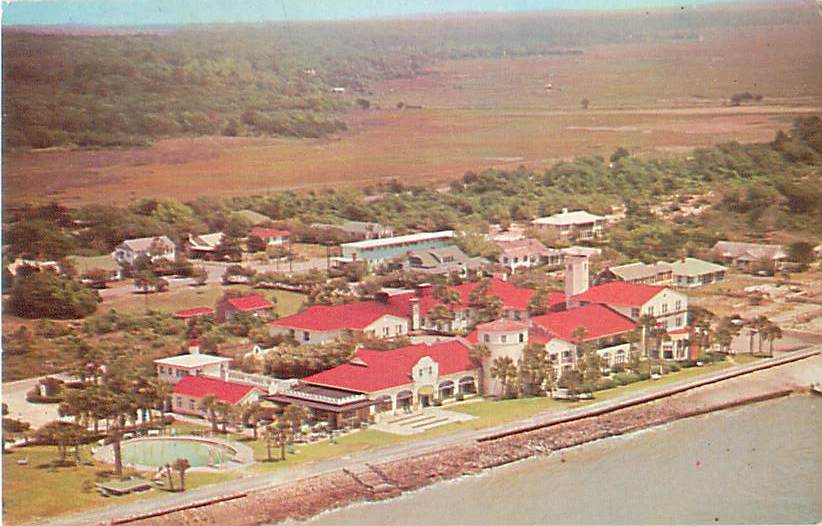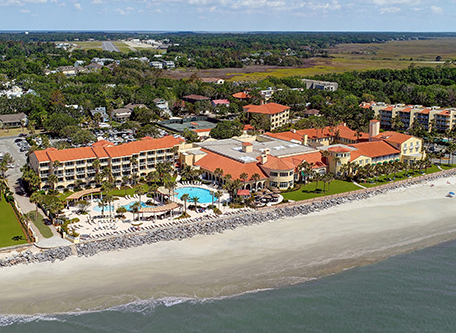Receive for Free - Discover & Explore eNewsletter monthly with advance notice of special offers, packages, and insider savings from 10% - 30% off Best Available Rates at selected hotels.
history
Discover The King and Prince Beach and Golf Resort, once a popular dance club, that offers magnificent views of the Atlantic Ocean.
The King and Prince Beach and Golf Resort, a member of Historic Hotels of America since 1996, dates back to 1935.
VIEW TIMELINEIntroducing The King and Prince Beach & Golf Resort Experience
Learn more about this beautiful, historic oceanfront resort located on St Simons Island, Georgia.
WATCH NOWDuring the first decades of the 20th century, a few affluent people developed a small, yet vibrant cluster of seasonal cottages near the famed lighthouse that sat toward the southern end of St. Simons Island. Within a matter of years, those homes were joined by a group of rudimentary hotels that serviced the increasing number of tourists who travelled to the island by boat. Soon enough, the introduction of the F.J. Torras Causeway in the early 1920s opened the island up to automobile travel for the first time. As such, the rustic seaside village that resided on the island rapidly swelled during the summer with unprecedented numbers from the mainland. A tiny railway system soon appeared that moved guests easily throughout the island, giving rise to various cultural attractions that catered to their exclusive entertainment. Among the most noteworthy real estate developers to arrive on St. Simons Island at the time was an vehicle manufacturer from Michigan named Howard Coffin. Observing the throngs of tourists walking the island, Coffin immediately recognized the area’s potential to host a prosperous resort community. He quickly set about purchasing land across the island, including large portions of a former 19th-century estate known as “Retreat Plantation.” In short order, Coffin created a wealth of new hospitality facilities, as well as several roads that could better transport people. The crown jewel of his empire was the Cloister Resort on Sea Island, which resided just to the north of St. Simons. Hosting clientele directly from St. Simons Island, it soon became the most exclusive place to stay in the Golden Isles.
Two entrepreneurs—Morgan T. Wynne and Franklin J. Home—enviously watched Coffin’s various enterprises flourish. In 1935, the men determined to create their own brilliant holiday destination that would rival the Cloister in its prestige. Purchasing a large allotment of land at the end of Arnold Road, they constructed a magnificent Spanish Colonial Revival-style resort hotel that rapidly became the talk of the town. Christened as the “King and Prince Hotel,” it especially developed a reputation for its exciting live entertainment and crazy dance parties. Many of the soirees even occurred outside, where guests were awestruck by the resort’s stunning views of the surrounding landscape. But a calamity struck two years later, when an accident caused many of the King and Prince Hotel to shutter its doors. Only the structure’s spectacular dining room was spared any damage. Undeterred, Wynne and Home committed to reopening their beautiful retreat. In 1939, they subsequently organized a corporation called the “King and Prince Surf Hotel, Inc.,” financed with some $20,000 in capital stock. According to the two, the purpose of this novel organization was to acquire as much of the local tourism industry as possible. In turn, Wynne and Home would use the proceeds from those endeavors to finance the reconstruction of the King and Prince Hotel. It worked wonderfully. They were able to completely refurbish the entire structure in just a matter of months, which gave the resort its current appearance.
The formal date that marked the reopening of the resort was July 2, 1941. But with the Japanese attack on Pearl Harbor that December, the United States quickly found itself in the midst of fighting the Second World War. German submarines were soon prowling off the Georgia coastline, hunting for American merchant vessels that had left nearby Brunswick on the mainland. In fact, two ships—the SS Oklahoma (not to be confused with the battleship) and the SS Esso Baton Rouge—were sunk just off the coastline of St. Simons Island. The War Department sent soldiers and sailors to occupy the many resort hotels that proliferated throughout the Golden Isles, in order to help spot those illusive vessels. The United States Navy subsequently used the King and Prince Hotel as a training facility and radar station that helped hunt down the U-Boats. But the navy also invested heavily into improving the infrastructure across the island. Its projects directly impacted the King and Prince Hotel, as well, for it built a seawall near its shoreline and drilled a well to supply the facility with a reservoir of fresh water. Those developments helped the King and Prince Hotel transition back into peacetime once the war had concluded in 1945. But the conflict had an unintended consequence on both the resort and the island as a whole—it had exposed a whole generation of servicemen and women to the area. As such, the veterans who had served on St. Simons Island returned to the King and Prince Hotel throughout the 20th century, transforming the location as one of America’s most exclusive vacation retreats.
Morgan T. Wynne eventually became sole owner of the King and Prince Hotel during the 1940s, although he gradually drifted his attention to new projects in the vicinity of Tampa, Florida. Management of the resort fell to an Atlanta-based company called the “Henry Grady Hotel Corporation.” It proceeded to manage the business for the better part of two decades, starting in 1947. It oversaw a series of additional renovations that constructed a swimming pool, boardwalk, and newer venues to allow for even larger dance parties. But by the 1970s, the resort began to decline in popularity. Much of the demise was attributed to the many different owners who had come to own the resort by this point. Eventually, the CMS Bank of America foreclosed on the business and started looking for a new ownership group. Then, in 1980, the bank reached an agreement with Mississippi Management Incorporated to acquire the resort. Spending the next two years thoroughly refurbishing the destination, the business invested millions into restoring the location back to its former glory. Subsequent renovations occurred in the early 2000s, which was certified by the Technical Preservation Services Branch of the National Park Service. The construction work proved to be so effective that the U.S. Department of the Interior even listed the resort on the National Register of Historic Places in 2005. More recently, the resort underwent a massive renovation called the “Castle Makeover,” which redeveloped several common areas and added a brand new restaurant called “ECHO.” Now known as the “King and Prince Beach and Golf Resort,” this outstanding historic destination is once again one of the most exclusive places to stay in Georgia!
-
About the Location +
The story of St. Simons Island harkens back to the mid-16th century, when Spanish colonists first attempted to establish Catholic missions along Georgia’s entire coastline. Two missions eventually appeared on St. Simons Island—San Buenaventura de Guadalquini and Santo Domingo de Asao. But the missions proved to be short-lived as the villagers fled south to Florida in order to escape constant raids by renegade pirates. Meanwhile, settlers from Great Britain established the Province of Carolina, whose borders stretched from Cape Fear to the Savannah River. As such, English and Spanish colonials often skirmished over control of Georgia’s coastline, as both countries saw the region as a buffer zone for their respective colonies. At the height of the conflict in the 1730s, General James Edward Oglethorpe founded a town at the mouth of the Savannah River that he called “Savannah.” From Savannah spawned the Province of Georgia, which directly functioned as the defensive cushion for the southern border of British America. General Oglethorpe further enhanced the colony’s role as a bulwark against potential foreign incursions by erecting Fort Frederica on the western coastline of St. Simons Island. Named for the heir to the British throne, Prince Frederick Louis, the citadel served as the main post for the United Kingdom in the southern colonies throughout most of the mid-18th century.
The Spanish threat toward Georgia eventually faded following their defeat at the Battle of Bloody Marsh during the strangely named colonial conflict known as the “War for Jenkins’ Ear.” The fort subsequently declined in its usefulness, save for a brief period during the Seven Years War. By the 1770s, the citadel’s garrison had completely relocated to the mainland, leaving behind only a few merchants who once serviced the location.In the years immediately following the American Revolution, St. Simons Island was largely uninhabited. The few people remaining on the island took to agriculture, growing cotton, rice, and various sustenance crops. As it turned out, cotton flourished within the climate of St. Simons Island. Soon enough, the locals began clearing large swathes of the region’s densely forested areas in order to create massive farms that would explicitly cultivate cotton. (Interestingly, the wood collected from St. Simons Island were used to build warships for the United States Navy, including the famed USS Constitution). Those farms gradually grew into 14 separate plantations, with Pierce Butler’s Hampton Point Plantation becoming the largest. By the dawn of the 19th century, Butler’s estate grew some 800 acres of cotton, as well as nearly 300 acres of rice.
In the wake of the American Civil War, various companies established lumber mills across St. Simons Island. Two New Yorkers named Norman Dodge and Titus G. Meigs opened the very first milling plant, setting off a chain reaction that saw many more appear throughout the area. Architect Charles B. Cluskey then designed a brand-new lighthouse to help facilitate the maritime traffic that was now routinely heading toward St. Simons Island. An unintended side-effect of the lighthouse soon emerged, in which local entrepreneurs began ferrying increasing numbers of tourists to the region. News quickly spread about the tranquil environment of St. Simons Island, inspiring families to establish their own summer houses along its shoreline. Several entrepreneurs also began constructing a few hotels and resorts as well, giving rise to a prosperous tourism industry that was to last well into the 20th century. Additional developments further enhanced the region’s appeal to tourists during the 1920s, culminating with the debut of the F.J. Torras Causeway. (More than 5,000 automobiles alone traveled the route on its very first day!) Both the temporary and permanent population of St. Simons Island rose exponentially during the 1940s, even as the nation found itself embroiled in the Second World War. Soldiers found the island to be very attractive as a vacation spot for when they left their respective bases for leave. This popularity continued to be strong for the remainder of the century, which transformed St. Simons Island into one of the most exclusive vacation hotspots in the entire country.
-
About the Architecture +
Designed by architect Laurence Miller and Felton Davis shortly before America’s entry into World War II, the King and Prince Beach and Golf Resort is a brilliant example of Spanish Colonial Revival-style architecture. In fact, the U.S. Department of the Interior has indicated that it is among the best of its kind throughout all of Georgia. A rare architectural form in the state, Spanish Colonial Revival style accounts for less than one percent of the historic buildings currently protected by the federal government in Georgia. The King and Prince best reflected the most popular aspects of the form, as its most iconic features involved low-pitched terra-cotta tile roofing and cantilevered balconies with decoratively sawn beams. Miller and Davis constructed the walls with a beige-colored stucco that contrasted wonderfully with the tile roof. They also rested the resort upon a P-shaped foundation, centered on an open courtyard as well as separate wings that contained the lobby, solarium, and kitchen. Both the lobby and one-story solarium resided on the northern side of the main building, while the kitchen and patio extended toward the south. Small, yet luxurious guestrooms existed on the second and third levels of the facility, including a magnificent bridal suite that provided amazing views of the Atlantic Ocean. Perhaps one of the most outstanding portions of the original King and Prince Beach and Golf Resort was its spectacular dining space. Situated between the kitchen and the patio, the room featured spectacular terrazzo flooring that displayed the image of a torch laid across a ship’s wheel. Furthermore, the walls of the dining room contained beautiful French doors, as well as stained glass windows developed by the Highpoint Glass and Decorative Company. Located in the transoms, the paneling depicted such important scenes in St. Simons’ history, including Fort Frederica, the St. Simons Lighthouse, and the Battle of Bloody Marsh.
In 1972—and again ten years later—the King and Prince Beach and Golf Resort underwent substantial renovations. The focus of both construction projects focused on restoring much of the original architecture, while also making the available services more appealing to contemporary travelers. Nonetheless, the historical integrity of the entire resort was respected by its owners, who saw it as a treasure worth preserving. In 1982, the King and Prince Beach and Golf Resort also saw the addition of a massive, two-story atrium that nearly doubled the size of the location. Along with providing a new lobby, it specifically included such spectacular facilities as a gift shop, indoor pool and several meeting spaces. Perhaps the greatest component of the atrium was the introduction of a new dining space that allowed the resort to become a leading culinary destination in coastal Georgia. Meanwhile, the former lobby and the solarium experienced a significant facelift, which reinforced the historical character of each space. Yet, they also received new finishes, such as a series of brilliant Tuscan columns. More recently, the King and Prince Beach and Golf Resort received even more renovations, which began in earnest in 2010. Lasting for three years, ownership called the “Castle Makeover.” Among the most significant developments that transpired as a result of the construction work was the creation of a brand-new dining facility called “ECHO.” Located just beyond the current lobby, the architecture of restaurant and accompanying bar reflected the rich maritime heritage of St. Simons Island. Other areas affected by the extensive renovation project covered the resort’s common areas, as well as its wonderful guestrooms.
-
Famous Historic Events +
Fifth Annual Bilderberg Meeting (1957): The Fifth Annual Bilderberg Conference met at the King and Prince Beach and Golf Resort from February 15 – 17, 1957. Like the previous conferences, the event constituted a gathering of leading figures from Europe and North America to informally talk about geopolitical issues that affect both continents. But much of the discussion at the Bilderberg Meetings attempted to reconcile the difficult topics that generated serious consternation among the nations in attendance. As such, the members of the conference ultimately try to set an agenda that may result in policy platforms that their wider world can subsequently adopt. To be invited to the Bilderberg Meeting, one had to be considered an expert in the fields of politics, industry, finance, and education, among other disciplines. And while many countries now have representatives at the more recent Bilderberg Meetings, the one held at the King and Prince Beach & Golf Resort in 1957 only had 12 in attendance. Nevertheless, those dignitaries—numbering 70 in total—attempted to resolve several serious problems affected their respective communities at that time. Of the various subjects introduced at the Fifth Annual Bilderberg Meeting, the most pressing involved:
- The rise of nationalism as disruptive influences on the democratic nations of the West
- Unfolding developments in the Middle East, especially in the aftermath of the Suez Crisis of 1956
- Relations with communist Eastern Europe, specifically East Germany and the prospects of reunification
Debates constituted the main form of discussion at the Fifth Annual Bilderberg Meeting, although joint conversations occurred, as well. Conference organizers circulated various background papers beforehand to prepare the attendees for the forums, too, so that the discussion remained constructive and energetic. In some cases, the authors of the documents would initiate dialogue with their fellow conference goers, before surrendering the floor to room. Yet, communication transpired in small groups, as a way of encouraging participation from all the members in attendance. The public was also shielded from the event, in order to dilute any outside sources from influencing the debates. In the end, those in attendance thoroughly enjoyed their three days at the King and Prince Beach and Golf Resort, finding its seaside location both tranquil and soothing.








































